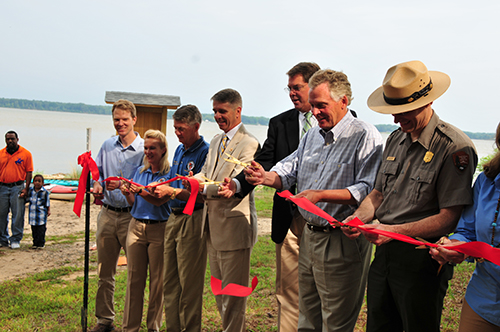New access demonstrates value of partnerships, Virginia’s commitment to access and Capt. John Smith Chesapeake National Historic Trail
 Caledon State Park, located on the Potomac River’s Virginia shore just upstream from the Harry W. Nice Memorial Bridge (US 301), is the latest access point to the Captain John Smith Chesapeake National Historic Trail.
Caledon State Park, located on the Potomac River’s Virginia shore just upstream from the Harry W. Nice Memorial Bridge (US 301), is the latest access point to the Captain John Smith Chesapeake National Historic Trail.
The park has six new campsites dedicated to paddlers on the trail.
The access points were developed through a partnership between Virginia, the National Park Service, and the Chesapeake Conservancy.
Governor Terry McAuliffe joined Joel Dunn, executive director of the Chesapeake Conservancy, Charles E. “Chuck” Hunt, the superintendent of the Chesapeake Bay Office of the National Park Service and local partners, to dedicate the new campsites.
“Partnerships like this one bring extra expertise and resources to the effort to create more public access to the Chesapeake Bay and its great rivers, and particularly to the Captain John Smith Chesapeake National Historic Trail,” said Dunn. He noted that creating access that enables people to explore the Chesapeake watershed’s outdoors is a part of Chesapeake Conservancy’s mission.
Gov. McAuliffe also affirmed Virginia’s commitment to increasing public access to rivers and the Chesapeake Bay.
“Protecting the health and vitality of Virginia’s waterways and promoting their use means we can connect people from all over the world with our Commonwealth’s natural resources and grow our economy as well,” Governor McAuliffe said.
He said his administration wanted to continue to provide more places for people to “swim, fish, put in a canoe and just be in nature.”
He noted that partnering with the National Park Service, the Chesapeake Conservancy and others will create more opportunities to create public access, and he added that the Commonwealth of Virginia and the National Park Service have agreed to a memorandum of understanding to advance mutual commitments to the Captain John Smith Chesapeake National Historic Trail and the Star-Spangled Banner National Historic Trail. A focus of the trails is to bring to the region new opportunities for public access, recreation, education and heritage tourism.
“Development of this canoe-in site increases people’s access to the river and to one of the country’s most significant summering spots for bald eagles,” said Virginia Secretary of Natural Resources Molly Ward. “This contributes to both the state park’s and the trails’ goals of allowing visitors to experience this area’s unique natural treasures.”
Canoe-in campgrounds were identified as a key need during development of the Chesapeake Bay Watershed Public Access Plan and the Potomac River Segment Plan for the Captain John Smith Chesapeake National Historic Trail (scheduled to be completed this year). Partners are working toward adding 300 new public access sites across the bay watershed by 2025.